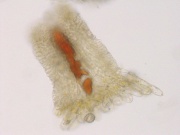Matricaria recutita (flower)
Contents |
Introduction
Introduction from Wikipedia, the free encyclopedia (http://en.wikipedia.org/wiki/Matricaria_chamomilla, retrieved 02/27/2012).
Matricaria chamomilla or German chamomile, also spelled camomile, is an annual plant of the composite family Asteraceae.
Matricaria chamomilla can be found near populated areas all over Europe and temperate Asia, and it has been widely introduced in temperate North America and Australia. It often grows near roads, around landfills, and in cultivated fields as a weed because the seeds require open soil to survive.
The word chamomile comes from the Greek χαμαίμηλον (chamaimēlon) meaning "earth-apple", which is derived from χαμαί (chamai) meaning "on the ground" and μήλον (mēlon) meaning "apple". It is so called because of the apple-like scent of the plant.
Matricaria chamomilla has a branched stem which is erect and smooth, and which grows to a height of 15–60 cm. The long and narrow leaves are bipinnate or tripinnate.
The flowers are borne in paniculate capitula. The white ray florets are furnished with a ligule, while the disc florets are yellow. The hollow receptacle is swollen and lacks scales. This property distinguishes German Chamomile from, Corn Chamomile (Anthemis arvensis), which has a receptacle with scales. The flowers bloom in early to mid summer and have a strong aromatic smell.
The quoted text in this section was licensed for use under the Creative Commons ShareAlike License, version 3.0: http://creativecommons.org/licenses/by-sa/3.0/
Macroscopic Entries
|
Microscopic Entries
|
|
HPTLC Entries
Other Points of Interest
Cite error: <ref> tags exist, but no <references/> tag was found

